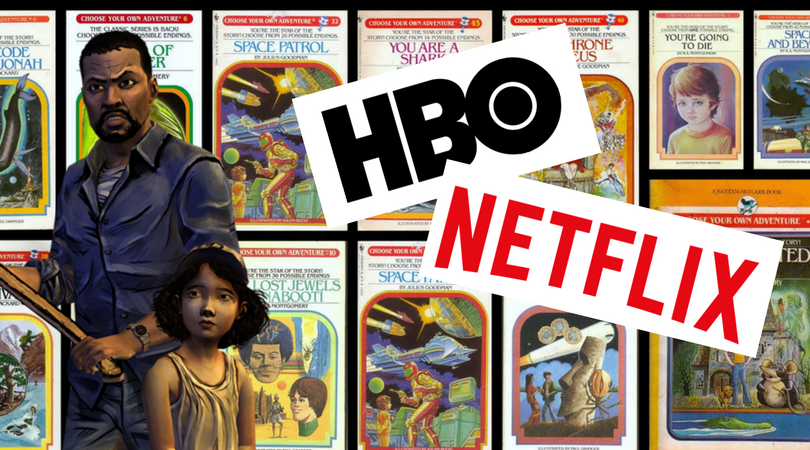
“Choose-your-own-adventures” make me think of the old, ’80s books that put you at odds with the abominable snowman in the middle of the mountains, asking you to turn from page to page to figure out what happens next. It was a concept that was awesome for young minds but fell into obscurity — maybe because of their difficulty to consume or just that their core audience just grew out of them.
But “choose-your-own-adventures” are making a comeback — they’re rising from the ashes of the ’80s and starting to gain traction in new forms from some of the biggest media companies around, from content companies like HBO and Netflix, and world-class IP like The Walking Dead and Batman.
Only these days they’re calling it “interactive media.”
And it makes sense: today’s world is so saturated with content (from quick consumption Facebook video to longform docs on HBO) that these big names are funneling money into interactive media to try to stand out from the crowd: to ignite attention that could spark popularity levels that we haven’t seen since the last Game of Thrones episode.
This battle for user attention is all well and good — but it’s also wise to adapt these lessons into the immersive theatre realm. For this segment, we’ll take a look Steven Soderbergh’s Mosaic and Telltale Games’ adventure game formula to examine what truly makes interactive media unique and what allows it to propel itself beyond the confines of the traditional linear narrative.
Let’s get started.
“Choose-your-own-adventures,” for those who are unfamiliar, are stories that place the audience in control of the narrative. Rather than telling one linear narrative path, the story challenges the reader to become engaged and, given a series of choices, the user can dictate where the narrative goes next by selecting pieces of dialogue, choosing where to travel, etc.
Telltale essentially resurrected this type of media from obscurity with their first slew of interactive games. It wasn’t until Walking Dead, though, that they truly had mass appeal with the addition of a bold IP and deep emotional resonance. Rather than clicking around to find goofy discoveries, each click could mean the life or death of a crew member. Each click deepened your relationship with your team. Your choices mattered; and for that matter, you mattered.
You weren’t just playing a game. You weren’t just entering into a shoot-em-up arena that pitted you against insurmountable odds. You were living with these characters for a few hours each week. You were getting to know them, as much or as little as you wanted. It was all up to you — and the story seemed to shape around your every action.

And this is where I think something like Steven Soderbergh’s Mosaic misses the mark, if only a little. His experience put you as a traditional observer of Molly Lake’s story. The entire series plays like a traditional TV show, save for your choice as to what episode you want to watch next, which, in turn, unlocks subsequent episodes that lead you down story-arc bunny trails.
But I found the process cumbersome. Even as a fan of the medium, even as I wanted desperately to include Mosaic in this written piece, I found it hard to continue to watch the show. That could be blamed on the writing, sure, but I think it goes far deeper than that. I think it was because Steven Soderbergh, as brilliant as he is, doesn’t understand why the “choose-your-own-adventure” process works so well and is so emotionally resonate.
You see, Mosaic asks you to watch the experience like any other TV show. You watch a series of camera angles, distancing yourself from each character and limiting yourself as only a passive observer. This would be fine, but his “branching narrative” doesn’t let you feel like you matter. Instead of playing a character, you’re playing director. Strike that, instead of playing director you’re playing an idle viewer who discovers answers to mysteries by pressing buttons as they are asked to be pressed.
Get KJ Knies’s stories in your inbox
Join Medium for free to get updates from this writer.
SubscribeSubscribe
It’s not organic. It’s not natural. And as a participant I don’t feel like I matter.
I believe that experiences like Mosaic and Netflix’s forays into interactive media miss the mark on what truly makes an interactive adventure special. You see, in a world of media consumption there needs to be a mode of media governing. It’s not so farfetched to say that you cannot view passive and active media artforms as pillars of the same building — they’re entirely different structures altogether. One asks the viewer to care — the other asks the viewer to be cared for.
Mosaic attempts to give the viewer agency while entirely missing the point of why that interactivity exists: to prove to the viewer that they matter. Soderbergh attempted to make the distinction that this was not a “choose-your-own-adventure” piece, rather a “branching narrative” piece, but I’m convinced that you cannot give viewers choice without inherently understanding why that choice exists.

And, in the much larger sense, this is why humans tell stories in the first place. Brian McDonald, a story consultant for some of the biggest names in the business like Pixar, argues that humans tell stories as cautionary tales. Years ago, humans who experienced danger returned to their villages to tell stories of danger, poison, and otherwise, to save their fellow villagers from hardship. At the core, though, humans shared stories of unique experience — spreading their singular experience to audiences of hundreds to audiences of thousands.
We tell stories of unique experiences and this is why “choose-your-own-adventures” are so important. Rather than the mundane feeling of the linear narrative, they empower creators to implant unique experience back into the human experience. They allow us to break open our endless days in the office, our boring commutes, and place us in a sequence of events that no one else in the world is going to experience in quite the same way. And we’re driven to talk about it.
Creative studios like Telltale allow us, for a moment, to recreate this sense of unique experience through a prism of free choice.
At the end of the day, this is not a defense of Telltale and their method of creating games. Heck, anyone who has played any of their titles more than once could interpret their promise of free choice as simply a marketing facade (spoiler alert: even the most desperate of choices only aesthetically change the remainder of the game).
It’s true. These games are not largely dependent on your choices. You could, theoretically, sit back and watch the entire experience unfold in front of your eyes passively, with little to no interaction. But even for the most veteran of players, we keep clicking. We keep making choices that largely have no merit to the macro level of the plot. So why do we keep clicking?
On the micro level, these choices matter. As an engaged player, we learn different information through different sets of dialogue. We can force a self-referential joke from a character that we’ve been waiting to hear the entire game. We can piss off those we hate and charm those we love. Sure, these choices won’t change whether or not that character becomes the hero at the end of the story, but it does change how we feel about them, how we perceive them to feel about us.
And it’s that distinction — the emotional vs. the intellectual forms of choice — which distinguishes Telltale and the surrounding genre from other forms of interactive play.
Going forward, I do feel that “choose-your-own-adventures” will continue to push the boundaries and breakthrough Telltale’s “prism” of choice into completely unique content for each player. When that will happen, and whether or not it will be good, is yet to be decided.
PS — Interactive narrative creators are constantly trying to figure out the “limited story path problem.” For a great discussion one of the more viable solutions, check out Ken Levine’s talk on Narrative Legos.
Mosaic is currently available for free on both iOS and Android. Read more stories in our ongoing series about what immersive theatre can learn from games.
No Proscenium is a labor of love made possible by our generous backers like you: join them on Patreon today or the tip the author of this article directly on Gumroad:
In addition to the No Proscenium web site, our podcast, and our newsletters, you can find NoPro on Twitter, Facebook, YouTube, Instagram, in our online community Everything Immersive, and in our Slack forum.




















Discussion